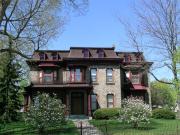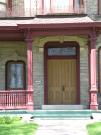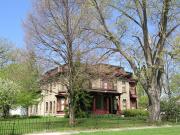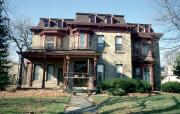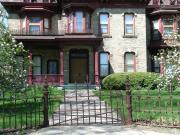| Additional Information: | A 'site file' exists for this property. It contains additional information such as correspondence, newspaper clippings, or historical information. It is a public record and may be viewed in person at the Wisconsin Historical Society, State Historic Preservation Office.
This was the home of Jesse Stone between 1875 and c. 1900.
Jesse Stone was born in England and came to Watertown by way of New York and Kentucky in 1869. He became a partner in the baking firm of Woodard and Stone as well as gaving other business interests in the community. He began his political career as a Republican assemblyperson and served in 1880, 1882, and 1897. He was very active in state-wide party politics, attending the national Republican convention in 1888 and 1892, and was a member of the state central committee between 1888-1894. In 1898 he was elected Lt. Governor, was re-elected in 1900, and served until his death in 1902.
This house is significant for local history under National Register criterion B because it is associated with Jesse Stone, a significant person in business and government in Watertown.
Jesse Stone was probably the most well-known and prominent of all of Watertown's nineteenth century politicians. After he became affiliated with an important industry in the community, he became active in local and state-wide politics. The culmination of his career came when he was elected Lt. Governor of the state. Because he was such a prominent person in government, helping guide the state and the Republican Party, this house, his long-time residence, is significant for its association with Jesse Stone.
Built in 1876 for Jesse Stone who had arrived in town to become a partner in the Woodard Wholesale Bakery and Confectionary business, this cream brick house is distinguished by a mansard roof with straight sides featuring arched dormers and broad overhanging eaves decorated with paired brackets. Featuring the projecting central bay typically associated with the Second Empire style, this imposing house is further characterized by multiple flat roofed wooden bay windows including a two-story bay window on the bay side of the facade, second story bay windows on the south bay and on ecenter bay of the facade and a mansard roofed bay window on the lower story of the south elevation. All of the bay windows feature stained glass dentil trim under the bracketed eaves and flat arched windows. Raised flat arched stone window hoods with articulated keystones ornament the tall, narrow flat arched windows. A mansard roofed front porch with cresting around the curb of the roof and dentil trim supported by carved posts on paneled bases corver two entrances: one double leafed door with transom window into the center block and a door with a stone arched hood similar to the window hoods into the south bay of the facade. A one and a half story extension with open porch is located at the rear of this U-shaped house. In addition, a brick carriage house and the 19th century iron fence encircling the house remains on the property.
The Jesse Stone house is significant under criterion C as an excellent example of the French Second Empire style. Clearly the best of the seven examples of the French Second Empire style remaining in the city, the Stone house exhibits the distinguishing characteristics of the style including the mansard roof and arched dormers, projecting center pavilion, classical moldings and roof cresting. Typical of many examples of the style, Italianate influence is seen in the bracketed eaves and interior ornament such as plaster cornices. The presence of the original carriage house or stable (56/34) and the iron fence adds to the architectural significance of this well-preserved 19th century house designed by Joseph Kern in 1876.
Other significant examples of the Second Empire style in the city include the Cody House at 114 No. Church (54/9), the Mulberger house at 31 So. Washington (54/32), the Globe Milling house at 623 So. 12th (35/20) and the Werlich house at 719 Market (45/22). |
|---|
| Bibliographic References: | (A) Evelyn Ruddick Rose, Our Heritage of Homes (Watertown Historical Society, 1980), pp. 14-15.
(B) C. Hugo Jacobi, "Reminiscences of Early Days in Watertown," Watertown Daily Times, March 18, 1924.
(C) Watertown Democrat March 2, 1876; Sept. 28, 1876.
(D) Watertown City Directories, 1866-1930, Watertown, Wisconsin Public Library.
(E) Dictionary of Wisconsin Biography, Madison: State Historical Society of Wisconsin, 1960, p. 340. |
|---|

